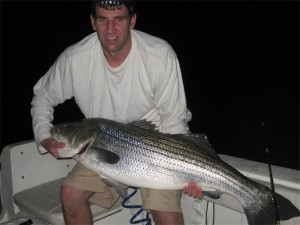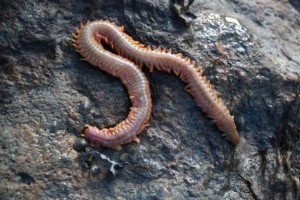The tube and worm is one the strangest, yet most effective methods of catching striped bass in the waters surrounding Cape Cod. Three foot long tubes routinely catch two foot long striped bass. 18 inch tubes often catch bass pushing well into the 40 pound range.
Needless to say there is a lot of mystique surrounding this deadly technique.
It would take quite a few articles to explain the theories behind why striped bass eat tubes. So instead of diving into tube and worm philosophy, lets explore how we can all improve our tube and worm success ratio by making a few alterations to our gear and techniques.
Locating an Area to Troll a Tube
Before placing a tube in the water, the most important decision an angler can make is deciding where to fish.
There are plenty of locations around Cape Cod that are suitable for trolling tubes. Scorton Ledge, the Elizabeth Islands, Cape Cod Bay, and Race Point often come to mind.

However one mistake that many anglers make is spending too much time trolling an area that does not hold any life. Trolling tubes has a natural tendency to put anglers to sleep-literally. It is extremely easy to just set the rods in the holders, and putt along for an entire afternoon, hoping to run into a nice school of striped bass.
Kicking back and relaxing is great, yet it is certainly not the most efficient way to fish the tube and worm. A more proactive approach is often necessary to locate a prime area with a lot of life. Spending more time on the move, and less time with the tubes in the water, will often result in more bass hitting the decks.
If this seems counter-intuitive to you, give Developing a Strategy for Finding Big Striped Bass and Tuna a read, to get a better understanding of what I mean.
Making Your Own Tubes
If you have the time, making homemade tubes can give an angler a competitive advantage over those who fish with store bought versions.
Most of the guys I fish with prefer to use unweighted tubes. Unweighted tubes can prove to be difficult to find at even the most fully stocked of bait shops. Unweighted tubes "swim" through the water column on a more natural, horizontal plane. Using tubes without weight also allows for more precise depth control.
Aside from the fishing advantages, homemade tubes can be made for less than $2/tube.
Rigging tubes is a pretty simple process that anyone with some wire, surgical tubing, pliers and patience can easily tackle. Stay tuned over the next couple weeks for an upcoming tube building video.
The Gear
Tube and worm rigs can be fished on monofilament, wire, braid and leadcore line. Wire line is beneficial when trolling in serious current, or dredging the depths. Monofilament comes in handy when fishing extremely shallow water. Leadcore and braided line fishes well across the spectrum.
90% of our trolling is done using 45 pound leadcore line. We load up a hundred or so yards of 50 pound dacron backing, and then attach 100 yards of leadcore via a slim beauty knot. The leadcore is conveniently marked at 10 yard increments by a change in color.
When using unweighted tubes, every 10 yards of leadcore placed in the water results in around five feet of achieved depth, considering an average trolling speed of around two knots. The ratio does not hold true if the trolling speed is considerably quicker or slower than two knots.
If we are marking bass at 15 feet below the surface of the water, then we will put three colors of leadcore in the water. If the bass are at 25 feet, then we will put five colors of leadcore in the water etc.
Precisely placing tubes at specific depths becomes more of a challenge when using weighted tubes. However weighted tubes are convenient when marking fish along the bottom in deep water.
Finding the Best Tube and Depth to Fish
Once an area holding bass is located, we can then work on discovering the most productive depth, tube size, and tube color to fish. The best way to do this is through a process of elimination.
I will typically troll three tubes when tube and worm fishing. One tube is trolled down the center of the Miss Loretta, while the other two are trolled off the port and starboard sides. All three tubes are trolled via leadcore line.
If fish are being marked throughout the water column, then the usual move would be to place the port and starboard lines at a specific depth (say five colors) and keep the line running down the center at a seperate depth (say three colors).
Tube color and size depends on the situation. The important concept to grasp is that it is important to alter your tube spread according to the reaction you are getting from the bass.
For example, if stripers consistently bite the 24 inch red tube on the center line (which has been set at three colors) then it could pay off to change the 30 inch orange tube you had running on the starboard line to a 24 inch red tube. Changing the starboard line to a depth of three colors instead of five colors may not be a bad idea either.
Hold On To Your Best Tubes
It is important to keep tabs on which tubes produce and which ones do not. Being able to make slight alterations to your next batch of tubes is another benefit of learning how to rig your own tubes.
For example, on many occasions one particular tube, at one particular length, exhibiting one particular motion will out fish all the other tubes in a fisherman's arsenal. It is difficult to pinpoint why this occurs, but I believe it has something to do with the way the tube "swims" through the water.

Sometimes bass hit a tube that curls clockwise and sometimes they hit a tube that curls counter-clockwise. Other days it seems to be flipped the other way around. One thing is for sure though-certain tubes out fish other tubes by a large margin.
So take a good look at which tubes in your bucket produce the most fish, and do everything you can to replicate them when trolling the tube and worm.
[ois skin="Tube and Worm eBook"]


I really enjoyed the info cant wait to try thanks Eric
Hey Eric, it’ll be time to splash the boat before we know it!